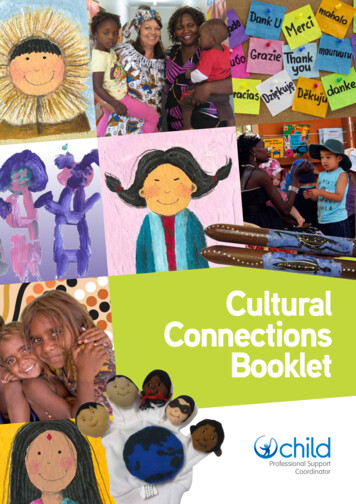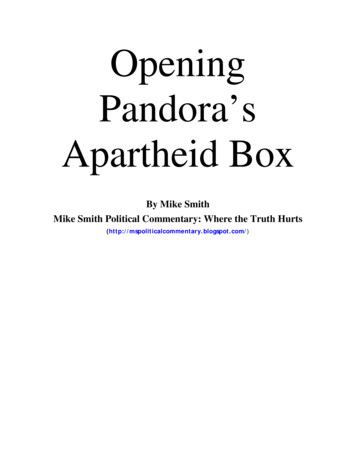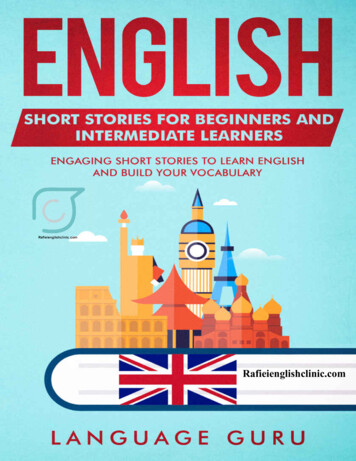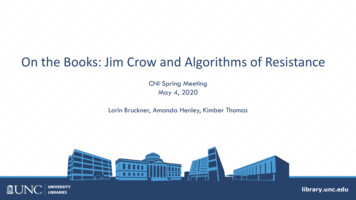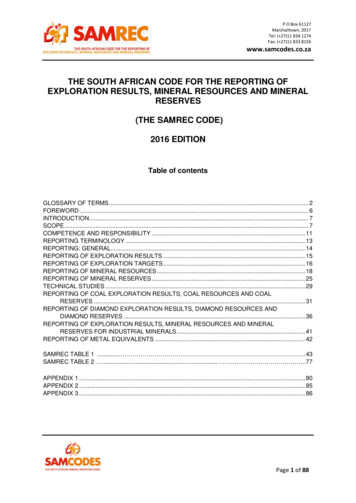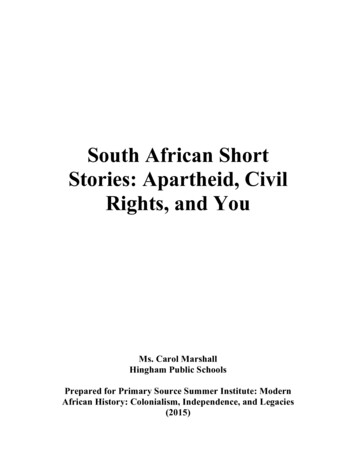
Transcription
South African ShortStories: Apartheid, CivilRights, and YouMs. Carol MarshallHingham Public SchoolsPrepared for Primary Source Summer Institute: ModernAfrican History: Colonialism, Independence, and Legacies(2015)
Carol Marshall, Hingham Public SchoolsAbstract:The legacy of Western colonialism in African history can be seen in much of theSouth African literature, and specifically through stories that deal with apartheid.Apartheid - Literally “apartness” in Afrikaans. A policy of racialsegregation introduced by the National Party after its electoral victory in1948. It created a highly stratified society in which whites dominatedpolitically, economically, and socially at the expense of pThese lesson plans will not only introduce students to a diverse group of SouthAfrican writers and literature, but they will also help students to begin to understand,in a personal way, how apartheid created discriminatory and despicable laws,boundaries, and limitations for those who lived in South Africa during this timeperiod. In these stories, the student will be introduced to characters ranging from theBritish colonialist and his family, to the Afrikaner, to black children and their familieswhose home is South Africa, to coloureds (a designation by the white-rulingNationalist party as a term for mixed races), and to a small population of Indians.Additionally, students will explore through a lesson plan on the Little Rock Nine,how race in America impacted citizens here in a profound way, proving that thelegacy of colonialism is the history of every African American citizen living todayand a challenge for every single citizen of the United States to overcome.When these lesson plans are introduced, students will have just finished a key textby Chinua Achebe, Things Fall Apart, published in 1958, through which studentslearn how colonialism impacted the Ibo of Nigeria during the late 1800’s and early1900’s. The short stories will provide additional, diverse perspectives and highlycompelling views of the legacy of colonialism and later apartheid. Africa is not “onestory”; on a continent with over 50 nations, one unit can only hope to showcase aselection of voices. Still, the use of authentic voices from another country in Africabeyond Nigeria will allow students to engage with multiple voices and perspectivesrelating to diverse, authentic, and specific concerns, dreams, and challenges in aparticular time and place. “Modern African literature is an astonishing and vibrant body of work, producedin multiple languages and from every part of the continent, including memoir, oralliterature, poetry, short fiction, novels and more.” (from Primary Source course materials- http://moodle.primarysource.org/course/view.php?id 230)Unit one of the World Literature curriculum for 10th grade begins with ThingsFall Apart by author Chinua Achebe, published in 1958 and recognized as a modernclassic of pre-colonial and post-colonial Africa in the country later called Nigeria. It is an2
Carol Marshall, Hingham Public Schoolseffective way for students to begin their formal study of the 10th grade World Literaturecourse because the text introduces students to many of the topics that students willexamine critically throughout the year – gender, race, religion, class, language, ancestry,diversity, culture, prejudice, tolerance, stereotypes, and more – surrounding one’sidentity.This specific series of lesson plans relating to African short stories will be asignificant addition to the text Things Fall Apart, by Chinua Achebe because it willexpand students’ knowledge of yet another region of Africa (South Africa), broaden theirknowledge of authentic African voices, and deepen their understanding of a key timeperiod/governmental policy in South Africa known as apartheid, which they also learnabout concurrently in their World History course. Some of the short stories I selectedwere introduced to me at the Primary Source course on Modern African History:Colonialism, Independence and Legacies. Others I selected from further independentresearch, often a result of a name or resource provided to me during the course. I selectedthe stories based on their accessibility to teens, the diversity of South African authors,and the many and varied character perspectives. The stories challenge the colonizers’racial assumptions and claims to cultural superiority and reveal social and economicexploitation through the late 1900’s (well beyond the time period covered in Achebe’snovel). Each of these selected short stories from South African writers help studentsexplore and grapple with the European assumptions that says one group/race (European)is superior to another (African). The western legacy of colonialism still impacts studentsin the way they perceive themselves, South Africans, and the world around them. Thelessons have been designed to help students understand how race, class, and gender roles,as well as other cultural parameters, are often artificially created or socially constructedand yet impact all cultures. This unit is also situated prior to the World LiteratureHolocaust unit (which comes later in the year), in which the European Jewish peoplewere exploited and subjugated by Nazi Germany. Many students will see parallelsbetween the Jewish people in Europe during the 1930’s-1940’s and the blacks’ situationin South Africa throughout the 1900’s, so these short stories will provide significantcontext for the Holocaust unit. This unit will also help students to understand the need toright the wrongs of colonialism (of which there is still a legacy) and empower them to goforward in a way that doesn’t repeat oppressive history. The Civil Rights era in theUnited States itself is mired in inequality arising from the history of slavery, tying inagain with the history of Africa and imperialist attitudes. Black Lives Matter, a currentgrass roots movement and mantra emerging now on the 2015 U.S. political scene will bea highly relevant issue in 2016 U.S. presidential election, as racial intolerance has been adominant factor in many recent news stories in which white (policemen) have abusedpower in many cases with black victims, both men and women.Significantly for the English Language Arts frameworks, in this unit students willread critically, cite textual evidence, determine themes, expand vocabulary, presentarguments, discuss texts using the Socratic method of inquiry, and write critically usingwell-structured forms with supporting evidence and write creatively and empatheticallyusing a variety of forms (narratives, poetry, short stories, etc.)3
Carol Marshall, Hingham Public SchoolsLength of UnitThis short story unit, comprised of (currently) about 7 short stories (most of whichare in a collection of short stories called Somehow Tenderness Survives: Stories ofSouthern Africa), can be used by any English teacher as a stand-alone short story unit, oras a supplement to a key text. These lessons, if used in their entirety, would takeapproximately three weeks to complete; however, if time does not allow this, teachersmay select from the individual lesson plans outlined in this paper, most of which can beused independently from the others. Also, while I have selected short stories and arrangedthe unit in scope and sequence to build on prior themes, there is no absolute orderrequired. However, the stories do seem naturally to follow the text Things Fall Apart,contextually and chronologically. One caveat: while my enthusiasm for this unit grew, Iadded more short stories and lesson plans. Realistically, I probably will have to pick andchoose from these stories myself, if I also plan to teach the novel Things Fall Apart;otherwise the “Africa unit” will be too long. I may substitute the short stories for thenovel for my honors or for my college prep sections (either/or), if I can get the book,Somehow Tenderness Survives: Stories of Southern Africa, for my students. I think it maybe out of print, as I couldn’t order it from my local Barnes and Noble bookstore and hadto purchase it on Amazon.Age of StudentsStudents are about 15 years old when they enter 10th grade in September. At this time ofthe year, students are more concrete in their thinking and perceiving situations; by theend of the year when most are 16, they become more aware of the subtleties, nuances,and perspectives of people’s stories. Helping students become more aware of “the grayareas,” and, ultimately, places where reconciliation can occur, is one of the goals of thecourse.Essential QuestionsFollowing are Essential Questions from the current World Literature curriculum whichstudents address with each unit. These will also be applicable to the African short stories.1. What can a book teach about the many dimensions of global culture at a particulartime and place?2. How do important historical or political shifts affect the lives of the people in aculture or society?3. What character traits are considered noble, heroic, or admirable in a particular cultureor society?4. How does fitting in or clashing with the cultural values of a society affect theindividual?5. What does reading about the culture and society of a different global area teach youabout your own culture and society?6. What is my role and purpose in a global community?4
Carol Marshall, Hingham Public SchoolsIn addition to the above questions, a postcolonial critic* uses some of the followingquestions to guide his or her analysis of a text. These essential questions are relevant aswell to the short story unit.*Postcolonialism’s major concern is “highlighting the struggle that occurs whenone culture is dominated by another.” Postcolonialism is born out of “thecolonized peoples’ frustrations; their direct and personal cultural clashes with theconquering culture; and their fears, hopes, and dreams about the future and[regaining] their cultural identity.” (Bressler)1) What happens in the text when the two cultures clash, when one sees itself superior toanother?2) Describe the two or more cultures exhibited in the text. What does each value? Whatdoes each reject?3) Who in the text is considered the “Other”?4) What are the forms of resistance against colonial control?5) Demonstrate how the superior culture’s hegemony affects the colonized culture.6) How do the colonized people view themselves? Is there any change in this view bythe end of the text?7) Cite the various ways that the colonized culture is silenced.Additional Essential Questions for Students to Consider§These questions will help students connect the themes of the unit to their own lives.1. Can you make any connections between these stories and the stories from theCivil Rights era in the U.S.?2. Looking back at the prior question #2, what are some of the different perspectivesyou have read about, and how does that help you build knowledge and empathyfor the characters/people depicted in these stories?Measurable Learning Objectives Students will learn how to use the QFT to create, pose, and prioritize questions thatwill enable them to explore topics independentlyStudents will define and be able to describe how apartheid governed South Africafrom 1948-1994, and they will reflect on its legacy.5
Carol Marshall, Hingham Public Schools Students will read and analyze short stories and be able to explain multiple waysracial bias impacted the colonized cultureStudents will read and analyze short stories and be able to explain multiple waysracial bias influenced the colonizerStudents will be able to describe the varied perspectives in the short stories throughthe cultural lenses of race, class, and genderStudents will identify and be able to describe multiple reasons for the unrest thateventually led to post-apartheid South Africa.Students will research and be able to describe writers of post-colonial literature inSouth AfricaStudents will read short stories and be able to identify motifs and themes, some ofwhich they will be able to connect to their own world: exile, compromise,exploitation, alienation, black consciousness, white privilege, black responses toapartheid; liberal response to apartheid (benevolence, self-justification, egotism);problems of belonging in a segregated society; place as a prison; redemptive power ofhumanityStudents will make connections between apartheid in South Africa with the CivilRights movement in the United States as a result of racism.Students will reflect on the causes of stereotypes, prejudice, and violence, and engagewith writing, discussion, and other activities that help to challenge these issues.Unit Outline:Day 1 – The Question Formulation Technique Day 2 – “A Day in the Country”Day 3 – “The Old Chief Mshlanga”Day 4 – “Crackling Day”Day 5 – “The Bench” or “The Toilet” (overview only)Day 6 and 7– “The Bridegroom” and “The Road to Raraba” (overview only)Day 8 – “The Road to Alexandra” (excerpts from Kaffir Boy) (overview only)Day 9 and 10 – Tsotsi viewing and film guide (book by Athol Fugard) (overview only)Day 11, 12 and 13 – “My Dear Mr. President” and The Little Rock Nine/Memory ProjectDay 14 and 15–Race, Stereotypes and Myth Busters ActivityDay 16 – Art and Poetry as Protest MediaHandouts (included at the end of the document)Learning Activities6
Carol Marshall, Hingham Public SchoolsDay 1 - The Right Question Inquiry ActivityObjectives Students will be able to generate their own questions to explore the meaning ofapartheid and its impact in S. Africa, making the learning personal and “sticky”(They care about the questions they generate – this is supported by the philosophythat all learning is motivated by “personal” interest). Students will be able to “practice three thinking abilities in one process:divergent, convergent and metacognitive thinking.” (from PowerPoint:rightquestion.org).Essential Questions These essential questions will be the ones students personally develop in theactivityMaterials The Question Formulation Technique PowerPoint for Students fromwww.rightquestion.org, presented at Primary Source, July 2015, by Linda Morse. QFT Small Group Worksheet “A Day in the Country” short story (homework)Time: one 58-minute class period, plus homeworkProcedure Direct Instruction –o Teacher will present the PowerPoint to teach students how to use the QFT.The Q-Focus, determined by the instructor, will be generated to suit thetopic. It should not be biased or opinionated. I will use the following QFocus: Apartheid and its Impact in South Africa. (Although students willbe studying Colonialism/Imperialism in Africa in their history courses,they may or may not have come to this topic in history at the same time astheir English class does. Therefore, apartheid, itself, may be a new andunfamiliar term for them. The instructor may need to define apartheid ifstudents do not know the meaning, in order for students to generateadditional productive questions.) Student Activityo Students will work in small groups to generate questions, etc. per thePowerPoint directions. Activity Debriefo Instructor will post the prioritized student-generated questions by group onedmodo for students to access for homework and explain the homework. Modificationso If the teacher does not use edmodo or other web-based resource forstudents to access materials, alternatively, students may take notes inclass, writing down the questions that are generated. Homework7
Carol Marshall, Hingham Public Schoolso Instructor will direct students to select three of the priority questions listedto guide them and to reflect on as they read and analyze the first shortstory – “A Day in the Country,” by Dan Jacobson (from SomehowTenderness Survives: Stories of Southern Africa, selected by HazelRochman, 1988). p. 46-60. For homework, students will be asked toaddress each of those three questions in a written response to the story (3full paragraphs, approximately 1 ½ pages, typed and double-spaced).Day 2: “A Day in the Country” by Dan JacobsonObjectives Students will be able to read about, analyze, describe, and interpret racism in S.Africa and its multiple perspectives from a white Jewish family, a white Afrikanerfamily, and a black family.Essential Questions What happens when two cultures clash, when one sees itself as superior toanother? What does this story tell you about the values of each of the groups or cultures?What does each value? What does each reject? Who in this text is considered “the Other”? How does fitting in or clashing with the cultural values of a society affect theindividual?Materials Student-generated responses to the story “A Day in the Country” from theirhomework assignment. “A Day in the Country” short story (student has this from last night’s homework) African Short Story Journal for writing responses (student should bring to classeach day) “Perspectives” handout (teacher provided) Guided Reading Questions for “The Old Chief Mshlanga” (for tonight’shomework)Time: one 58-minute class periodProcedure Do Nowo Describe a situation in your life when you were a bystander and saw awrong occur. Did you intervene? Remain quiet? What were youremotions? Write a brief one-paragraph reflection in your South AfricanShort Story journal for today’s page and story, “A Day in the Country.”8
Carol Marshall, Hingham Public SchoolsStudents may be instructed to volunteer to share responses with the class,or they may turn to a partner and share their experiences. Student Activityo Students share homework responses with their set (from three questionsfrom the QFT in response to “A Day in the Country”).o Perspectives Activity: Assign groups of four students one of the threefamilies to discuss - the white Jewish family (in the car) and narrator ofthe story (a boy in this family), the Afrikaners (in the other car),individually and as a family, and the black family and child. Instructstudents to examine the roles/perspectives in the situation according totheir assigned family. Have students discuss and write their answers.Students will then present their group responses to the class.o Students will go back to the handout to complete part 2. This part includesadditional questions to consider and vocabulary. Students may work ingroups to fill out the handouts individually, which will become note takingresources to study from for quizzes or a unit assessment, which could alsobe a test, essay, or Socratic seminar.) Activity Debrief (these questions are on the handout)§ What does the story tell you about race relations in apartheidS. Africa?§ What other questions do you have, based on the story? Studentscan write these additional questions on the handout for furtherexploration. Wrap-Up/Reflection/Summaryo If there is time, instruct students to write a brief written reflection in theirjournal on their understandings and take-away from this story HomeworkRead “The Old Chief Mshlanga” by Doris Lessing, p. 23-45 and answer theguided reading questions provided.Day 3: “The Old Chief Mshlanga” by Doris LessingObjectives Students will be able to describe how apartheid works in S. Africa from theperspective of the colonizer and the colonized Students will analyze and interpret stories through the lenses of race (ornationality), class, and gender roles to understand how and why perspectives maydiffer Students will be able to describe superiority and victimization from multipleperspectives9
Carol Marshall, Hingham Public Schools Students will be able to explain how the setting of a story helps to reveal thenature of the protagonist and other charactersEssential Questions How do children learn prejudice and hate? Does prejudice and hate in one’s early years guarantee that one will grow up to bethe same? How does one’s gender play a role in the way characters perceive themselves andtheir ability to act independently? What happens when two (or more) cultures clash, when one sees itself as superiorto another? What does this story tell you about the values of each of the groups or cultures?What does each value? What does each reject? How does fitting in or clashing with the cultural values of a society affect theindividual? What cultural traits are considered noble, heroic, or admirable in a particularculture or society? How is the policy of apartheid revealed in this story?Materials Guided reading questions homework assignment from prior night’s homework.(student has) “You’ve Got to be Carefully Taught” handout “The Old Chief Mshlanga” (student has) and “Crackling Day” (new handout forhomework) short stories African Short Story Journal for writing responses “Perspectives Activity for “The Old Chief Mshlanga” by Doris Lessing handout(teacher provided)Time: one 58-minute class periodProcedure Do Now: “You’ve Got To Be Carefully Taught” lyrics and response activator Student Activity: Perspectives in “The Old Chief Mshlanga” short storyExamining Perspectives through the Lenses of Race (orNationality), Class, and Gender. (see handout)Students should use their guided reading questions to helpwith the activity. Activity Debrief (these questions are on the handout)§ What does the story tell you about race relations in apartheidS. Africa?§ What other questions do you have, based on the story? Students can writethese additional questions on the handout for further exploration. Wrap-Up/Reflection/Summary10
Carol Marshall, Hingham Public Schoolso If there is time, instruct students to write a brief written reflection in theirjournal on their understandings and take-away from this story1) Homework: Read “Crackling Day” by Peter Abrahams and complete the GuidedReading QuestionsDay 4 : Crackling Day” by Peter AbrahamsObjectives Students will be able to describe how apartheid works in S. Africa from a child’sperspective Students will be able to describe superiority and victimization from multipleperspectives Students will be able to explain how the setting of a story helps to reveal thenature of the protagonist and other charactersEssential Questions How do children learn prejudice and hate? Does prejudice and hate in one’s early years guarantee that one will grow up to bethe same? How does one’s gender play a role in the way characters perceive themselves andtheir ability to act independently? What happens when two (or more) cultures clash, when one sees itself as superiorto another? What does this story tell you about the values of each of the groups or cultures?What does each value? What does each reject? How does fitting in or clashing with the cultural values of a society affect theindividual? What cultural traits are considered noble, heroic, or admirable in a particularculture or society? How is the policy of apartheid revealed in this story?Materials In Class Activity Questions #1-9 and Perspectives Chart “Compare and Contrast“The Old Chief Mshlanga” and “Crackling Day” Biographies for Doris Lessing and Peter Abrahams Guided Reading Questions for homework – “The Bench” (10-2 – honors)(included) or “The Toilet” (10-3 – college prep) (not included)Time: One 58-minute class periodProcedures Student Activityo In groups, students will review the guided reading questions for“Crackling Day” from the prior night’s homework (Part I)11
Carol Marshall, Hingham Public Schoolso In groups, students will discuss their assigned guided reading question forthe activity (Part II) and chart their response in the handout (see handout)o Student groups will present three points to the class based on theirquestion and responses for both stories. De-Brief/Wrap-Up/Journal EntryAfter students have responded to the questions and taken notes during the grouppresentations, they will read on their own the biographies on Doris Lessing (“OldChief Mshlanga”) and Peter Abrahams (“Crackling Day”). They will respond intheir journal to the following questions:o How do you think the authors’ backgrounds might have influenced theirstories?o Are both perspectives important? Authentic?Day 5: “The Bench” by Richard Rive (guided reading questions included)or “TheToilet” by Mhlope (lesson plan not included)OverviewBoth stories deal with a teen’s or young adult’s perspective on apartheid and how it isimpacting his or her life. “The Bench may be given to an honors class, as it seemsaccessible to a more advanced 10th grade reader, while “The Toilet” is highlyaccessible to the college prep 10th grade student. Because each story is from a youngadult perspective, this adds to the students’ engagement with the stories and helpsthem to connect with their own lives and future, and the importance of makingthoughtful and independent decisions at this time in their lives, just as these twocharacters do – the young man in “The Bench” and the young woman in “The Toilet.”Possible Assignment or ExtensionThese stories lend themselves to an interesting creative writing assignment. Bothstories deal with the motif of a “place” and how this place is integral to theprotagonist making an important decision in his or her life – the young black mandecides to flout apartheid’s laws and sit on a “whites only” bench. The young woman,who had hidden in a public toilet for “sanctuary” and to seek freedom of expression(she writes while she is in the toilet while she waited for a bus to take her to anapproved job) finally decides to liberate herself and write out in the open.The assignment: Write about a “simple place” (i.e. not much bigger than the personalspace around you” that gives you or a fictional character an identity.a. Brainstorm: Visualize places you were this summer. Isolate one smalllocation, not much bigger than your own personal space. Give this spacemeaning to the protagonist in terms of an important or independentdecision he or she makes about his life.b. Students should be given some direction as to # of paragraphs for thestory, type of narrative (fiction or non-fiction), dialogue or not, etc. Theteacher should give some direction and create a rubric to meet theserequirements.12
Carol Marshall, Hingham Public Schoolsc. For example, a possible structure may bei. Paragraph 1: Exposition: Describe the character, the setting, andthe conflict (decision to be made).ii. Paragraph 2 (and 3 if needed): Create a scene in which thecharacter (or you) uses space as a decision making tool or a way toformulate identity. Make sure the internal conflict is apparentthrough interior monologue or thoughts/iii. Paragraph 3 or 4: In your conclusion, make sure your readerunderstands how this space has been important to the character’sgrowth.Day 6 and 7: “The Bridegroom,” by Nadine Gordimer (honors) and“A Farm at Raraba” by Ernst Havemann (college prep)(Honors could compare/contrast both) (An overview is presented here, but the actuallesson plan is not included)Overview:In The Bridegroom, by Nadine Gordimer, an Afrikaner man, who is employed in publicworks on the roads seems to be content with his rural and isolated life, far from any otherAfrikaners. He is the only white man depicted living among a crew of black workers,their wives, families, and “their women.” (Tomorrow, the protagonist will be married,and of course, life will change. However, tomorrow seems distant and not well thoughtout.) Clearly, he is used to the everyday routines of his life. He enjoys the security, peace,and close but separate living arrangements with the black workers. He has a“manservant” named Piet, a black man, who cooks and cleans for him, and with whom hehas what, if it weren’t for apartheid, might be called a friendship. Similarly, in “A Farmat Raraba,” the protagonist, an Afrikaner named Martinus, is isolated in his position as asoldier, with many black soldiers in his company or troop. One day, he kills some black“enemies,” but one is merely wounded. In an unusual turn of events, he develops an“almost friendship” with this man, and, ironically, the two talk of getting together afterthe war at a farm at Raraba, where the Afrikaner would be the foreman and the black manwould be the boss. (It is assumed that the blacks will win this war.) After the war, theAfrikaner seeks out his “friend”/former captive in Raraba, which, it turns out is just aname for a dream world. In both stories, these white men seem to fantasize a possible coexistence in which blacks and whites are friends (Even while they may not recognizetheir own attitudes, the reader senses these feelings.)Possible Assignments or Extension: These short stories have two white adult male protagonists, and seem to add furtherscope and sequence to the stories, which, to this point have focused on children, bothgirls and boys, and distinctly separate lives between whites and blacks. The rural,isolated, workaday settings, add yet another dimension to the stories. Motifs includeall of the following: exile, compromise, exploitation, alienation, black consciousness,white privilege, black responses to apartheid; liberal response to apartheid13
Carol Marshall, Hingham Public Schools (benevolence, self-justification, egotism); problems of belonging in a segregatedsociety; and redemptive power of humanity. Students could explore one or several ofthese motifs, or recurring thematic elements, and write an essay on how a motif helpsto develop a theme in one of these stories.Possible essential questions to consider include:o How does the isolation of setting allow the protagonists a certain closeness tothe blacks (and vice versa) that apartheid might not otherwise allow?o How does apartheid almost not matter in these stories?o How is the dream motif used in each story? What realities do exist in theirlives and how will these men be forced to awaken to those realities?o Who has the power in the friendship/relationship in each of the stories – thewhite man or the black man?Day 8: “The Road to Alexandra,” Mark Mathabane (An overview is presented h
by Chinua Achebe, Things Fall Apart, published in 1958, through which students learn how colonialism impacted the Ibo of Nigeria during the late 1800’s and early 1900’s. The short stories will provide additional, diverse perspectives and highly compelling views of the lega


